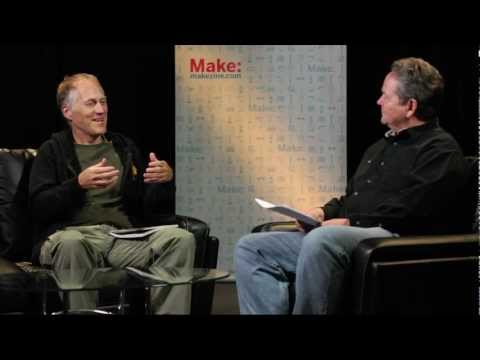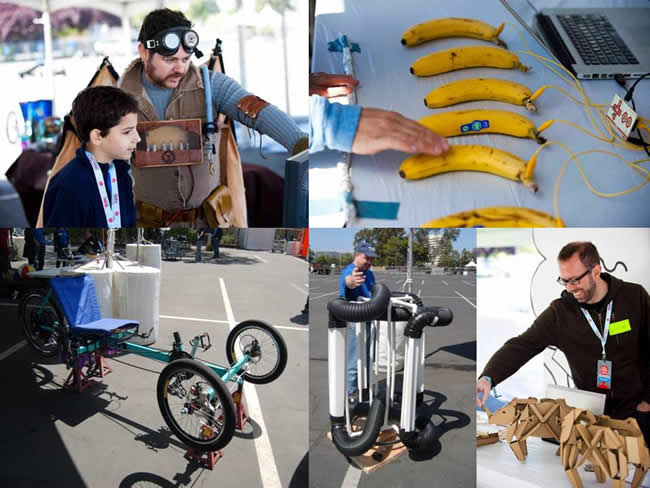Subculture, movement or worldwide network, the maker movement is driving innovation and invention in the 21st century, and shares technical communication ties in two of its champions, Tim O’Reilly and Dale Dougherty.
 In every age of scientific exploration, there have been stories of the everyman inventor, the humble pioneer who changed the world while working from scratch. The 19th century had the story of the Curies discovering radioactivity in a petri dish, while the 20th century had the stories of Alexander Fleming turning moldy bread into penicillin, and Bill Gates selling the first Microsoft computers out of his car.
In every age of scientific exploration, there have been stories of the everyman inventor, the humble pioneer who changed the world while working from scratch. The 19th century had the story of the Curies discovering radioactivity in a petri dish, while the 20th century had the stories of Alexander Fleming turning moldy bread into penicillin, and Bill Gates selling the first Microsoft computers out of his car.
The 21st century may well tell the story of the “maker movement”, a subculture of inventors, engineers and scientists who create everything from open source software programs to personal robots in their spare time and with their own materials. This century may be the age of the invention community – ordinary people sharing the simple joy of creating something with their own two hands with a worldwide network of their fellow inventors.
From within their basements, hobby shops and garages, “makers” have emerged as a force to be reckoned with.
“It’s about participatory culture, making instead of just consuming,” says Dale Dougherty, Vice President of O’Reilly Media and publisher of Make and Craft, the magazines of record for the maker movement. “There is room to evolve, with people of all ages participating, wanting to get involved and learn how to make things.”
Maker culture has been called “punk rock science” – a do-it-yourself renaissance in which people experiment with and develop their own inventions in garages, community rec centers and makeshift laboratories called “hackerspaces”. The movement started out in the late 1990s and the early 2000s as an outgrowth of the DIY movement, in which weekend inventors and designers created, from scratch, everything and anything they could imagine.
![]() Drop in on a hackerspace or go to a Maker Faire, an exposition of maker crafts and devices, and you’ll see the fruits of an imagination let out to play – electric vehicles, homemade computers and circuit boards, electronic toys of all shapes and sizes, and even battle robots.
Drop in on a hackerspace or go to a Maker Faire, an exposition of maker crafts and devices, and you’ll see the fruits of an imagination let out to play – electric vehicles, homemade computers and circuit boards, electronic toys of all shapes and sizes, and even battle robots.
You can now find Maker Faires all over the world, from a huge event in Atlanta, Georgia earlier this month to a “Maker’s Manifesto” scheduled for early November in Lagos, Africa. Planetariums and science museums nationwide host conventions for makers and their inventions. The maker movement has even found fans in the federal government: The Defense Advanced Research Projects Agency this year gave grant awards to finance hackerspaces in 16 California high schools.
“What is most exciting about the maker community is that it’s so collaborative,” says David Perry, Director of the Oregon Museum of Science and Industry (OMSI), which earlier this month hosted a mini-maker faire. “It’s all happening fast and publically, with people sharing information in order to advance these technologies. Also, these people are spending their own time and money, so there’s more passion than with someone who is working a corporate job.”
In short, the world of maker culture is one in which anything is possible.
“It’s a culture that celebrates ingenuity, creativity, and hands-on craftsmanship,” says Renee DiResta, an associate at OATV, a seed stage investment firm affiliated with O’Reilly Media specializing in new technology. “It’s about bringing an idea to life, tinkering, sharing. There’s a playfulness underlying the movement, a desire to understand the world. Some of what is produced solves a problem, while some of it is about artistic expression. Ultimately, it’s really about people.”

Tim O’Reilly and Dale Dougherty, co-founders of O’Reilly Media and proponents of the maker movement discuss the Hardware Innovation Workshop held in May 2012. (Image source: Gareth Branwyn and Makezine.com)
Open source technology is one of the key components of the maker revolution; using open source software, people can share their designs and devices with other, like-minded inventors and designers and collaborate with them to experiment with and improve upon the original.
“Open source is about creating a culture of sharing, to make your work available for people to actually see it,” Dougherty explains. “With open source, you can share, for example, the design of a circuit board so others can modify it.”
Hackerspaces serve as the breeding grounds of innovation within maker communities. In these community-run creative spaces, of which there are more than 100 in the U.S. alone, makers work on their designs and devices within a collaborative framework
“Hackerspaces are popular among makers not only because of the shared tools and common space, but because people love to discuss their projects,” says DiResta. “The community is interdisciplinary, so everyone brings something unique to the table. There’s a ‘remix’ culture at work – why duplicate something that someone has already done well, when you can just build on it and potentially make it even more awesome? It’s a bit like improvisation in jazz, where individual creativity and collaboration take a pre-existing melody in a new direction.”
The creative, improvisational spirit of the maker movement has found a powerful friend in O’Reilly Media, which has championed the movement since its beginnings. The company publishes both Make and Craft, and the company’s founder and CEO Tim O’Reilly regularly writes about new developments in maker culture on his blog, radar.oreilly.com. (O’Reilly was not available for an interview.)
According to Dougherty, one of O’Reilly Media’s cofounders, the company advocates on behalf of maker culture because it fits the company’s vision of new and better technology created through individual vision.
“Makers’ energy in trying to create new objects is fundamental,” he says. “I like the creative energy of makers, and I think that will be a big part of the industries of the future.”

Images from the Bay Area Maker Faire, held in May 2012, shows the many facets of the maker movement, which gaining support from major corporations such as Intel. (Image source: Karen Tanenbaum blogging for Research@Intel)
Maker culture is slowly but surely becoming an industry unto itself; the last few years have seen several makers become entrepreneurs. In 2009, Massimo Banzi started marketing Arduino, an open source electronics prototyping platform, after developing it as a teaching tool for his students at the Interaction Design Institute in Ivrea, Italy. That same year, Bre Pettis started MakerBot Industries, a New York-based 3D printer company, after experimenting with a printer prototype with his friends and business partners, Adam Mayer and Zak Smith.
“There are a number of companies that are outgrowths of maker culture,” she says. “The cost of prototyping has dropped – which itself is partially because of companies like Arduino and MakerBot – and the number of hardware startups has increased. We’re seeing more startups that are hybrid hardware-software companies. There’s a lot of cross-pollination, a lot of inspiration taken from maker culture.”
Maker culture is influencing several professional disciplines, such as technical writing and journalism. The movement’s combination of technical savvy and DIY ethic has inspired many writing and technology professionals to try their hand at developing their own designs and inventions in their spare time; for example, Nick Bilton of the New York Times is one of the founding members of NYC Resistor, a popular hackerspace.
“At O’Reilly, there are several folks with technical writing backgrounds who also tinker in their spare time,” says DiResta, who adds that she is not speaking on behalf of the technical writing community. “I can attest to the fact that it’s very interdisciplinary.”
That influence works both ways. Because many makers work in technical communication-related fields, some maker communities are learning to function more like companies. One example is Artisan Asylum, a Massachusetts-based hackerspace with its own board of directors.
“Places like Artisan Asylum are run more like a business,” says Dougherty, who started his career at O’Reilly Media as a technical writer. “Some hackerspaces are more like companies, even with boards of directors.”
According to Dougherty, maker culture has become a new frontier for technological research, a brave new world in which weekend inventors are restoring hope to stagnating sectors of the economy, presenting new opportunities for growth in an uncertain job market.
“Makers are basically doing research and development,” he says. “We see people starting their own companies, but also getting hired on to companies. To use the example of the manufacturing sector, people are using new technology like robotics to create things. That’s important at a time when there is talk of America losing its manufacturing power, the ability to make things.”
This new chapter in the story of the everyman inventor is only just beginning, says DiResta.
“There’s a lot of energy in the space right now; it’s frequently compared to the personal computer revolution of the 1970s,” she says. “Crowdfunding and active communities are driving a lot of innovation, and widespread news coverage is drawing people in. Hackerspaces are popping up across the country. We talk a lot about the ‘Next Industrial Revolution’ and ‘Smart Networks of Things’ here at OATV. We believe that’s where things are headed.”